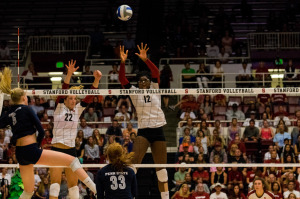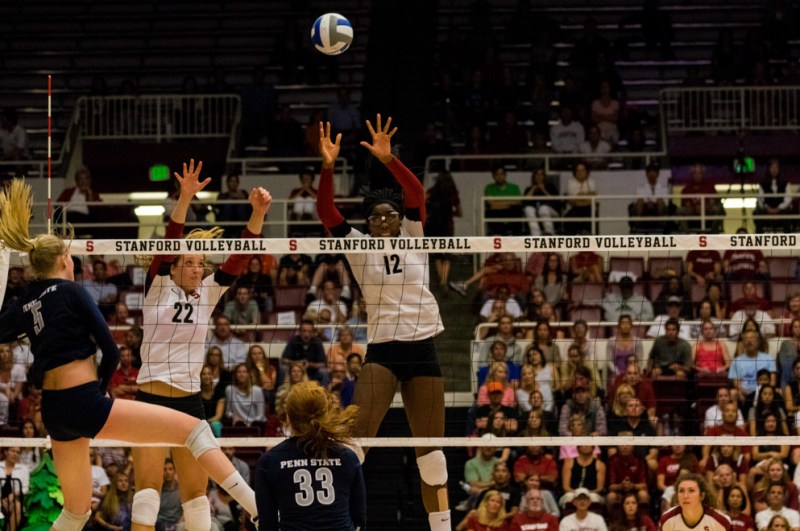Before the start of this year’s women’s volleyball campaign, I asked junior Inky Ajanaku what she could possibly look to improve on, following a season in which she was the only sophomore honored as an AVCA First Team All-American. Her answer: “I have a long laundry list of things I need to learn. It’s a question of what can I get better at, it’s a question of what can I mark off the list because right now, all the boxes are unchecked.”

My first thought was that if she had sent a page-long list to head coach John Dunning over the summer, thousands of other collegiate volleyball players in the country must have full-length novels prepared for what they need to work on. Sure, even the best athletes work to improve their craft, but the mindset that Ajanaku brings to volleyball is a distinct one.
“My athleticism has given me opportunities that other people don’t have, but I feel that in the mental part of the game, I have tons to learn,” she said. “I want to be known for being a smart volleyball player. I already have a little bit of the athleticism, but that’s not what I want—I don’t want to limit myself there.”
Ajanaku, a 6-foot-3 middle blocker from Tulsa, Oklahoma, undoubtedly has the athleticism to out-compete her peers. Her prowess has been on display since her freshman year, when she first earned a spot in Stanford’s starting rotation. She was an AVCA All-America honorable mention in her first season on the Farm, hitting .372 and averaging 2.42 kills per set.
She fully broke out in her sophomore season, gaining national recognition, as well as placing her name toward the top of Stanford volleyball’s record book. She finished the season with a .438 hitting percentage, the third-best single-season mark in program history (minimum 200 attempts), 2.72 kills per set and 1.38 blocks per set.
Still, she feels that there was more to be desired last season both in the team’s performance — after a loss to Penn State in the quarterfinals of the NCAA tournament, she said, “This loss is going to burn in our minds until December” — and her own individual play.
Ajanaku said, “Maybe if I knew a little bit more — if I had better eyes to stop some balls in that Penn State [quarterfinal] match. It doesn’t matter how high you jump; if you don’t know what to do with your hands, you’re just a jumping body in the air.
“I’m proud to know that I’m ignorant about a lot of things and I’m not scared to ask advice. In volleyball, there’s a constant game between middles and setters. [Opposing] setters try to trick the middles, middles try to read the setters and get a good block. And so I ask [setter Madi Bugg]: What are you thinking and what are you doing? And she’ll tell me, or sometimes she won’t because she wants to trick me.”
Once again, for Ajanaku, it all goes back to the mental aspect of the game, and what more she can learn, especially as she becomes one of the veterans and leaders of the Cardinal squad. Her opportunity to practice with the United States’ national volleyball team in Anaheim, California last summer allowed her to reevaluate her goals in the sport and adjust her approach to training.
What do you think of our latest Coaching Volleyball 2.0 cover? pic.twitter.com/PA0iAdjb2Y
— AVCA (@AVCAVolleyball) October 1, 2014
“She got to see the level that people that are older, playing in pro leagues around the world, play at. It’s how they approach the game, how serious they are about learning everyday,” Dunning said. “She came back with a different, more mature understanding of what it is she can do. And yes, she is already a First Team All-American, but she knows how much better she can be and she is one of those players that could just end up being almost limitless.”
“The national team gym gave me a solid thing to work for and know how good I need to be. Ever since I left, I’ve just wanted to get better,” Ajanaku said. “I cherish the time in the gym more because we probably only practice about three hours a day. I saw how [the national team players] cherished practice time, and that’s a testament to how focused they are and how driven they are.”
Since coming back from Anaheim, Ajanaku has developed a training routine, finally succumbing to the prodding of Dunning and associate head coach Denise Corlett that has dated back to her freshman year. Through Stanford’s first 14 matches this season, she is hitting .488—good for second in the country behind only her teammate, sophomore middle blocker Merete Lutz (.551)—and leads the team with 3.60 kills per set.
Before the season began, when I asked Ajanaku about having to deal with the spotlight after perhaps slipping under opponents’ radar last year, she said, “That would be the best thing that could ever happen to me. People working harder to stop my kills and shoot around my block would push me to become better.”
Stanford fans luckily have another year and a half to witness that awe-inspiring swing of Ajanaku’s, and now they can know that, behind that powerful spike and zestful personality, lies a determined mindset and a positive attitude.
Contact Jordan Wallach at jwallach ‘at’ stanford.edu.
